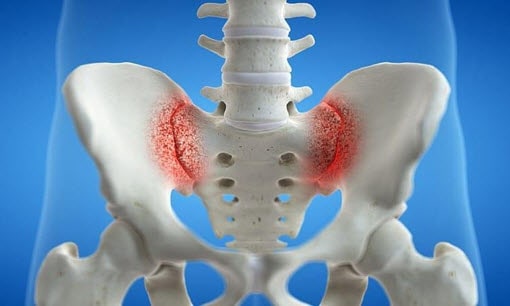
Sacroiliac Joint Dysfunction
Sacroiliac joint dysfunction, also known as SI joint dysfunction, is a condition that affects the sacroiliac joint, which is located at the base of the spine where the sacrum and ilium bones meet. This joint is responsible for connecting the spine to the pelvis, providing stability and allowing for limited movement.
When the sacroiliac joint becomes dysfunctional, it can lead to pain and discomfort in the lower back, buttocks, and legs. This condition is often characterized by a dull, aching pain that is worsened by activities such as sitting, standing, or walking for prolonged periods. The pain may also radiate to the groin or the back of the thigh.
It is important to note that sacroiliac joint dysfunction can vary in severity and may present differently in each individual. Some individuals may experience occasional flare-ups of pain, while others may have chronic and debilitating symptoms.
Diagnosing sacroiliac joint dysfunction can be challenging as the symptoms can mimic other conditions such as herniated discs or sciatica. Therefore, it is crucial to consult with a healthcare professional, such as a chiropractor, who specializes in musculoskeletal conditions to receive an accurate diagnosis and appropriate treatment.
Symptoms & Different Stages of Sacroiliac Joint Dysfunction
Sacroiliac Joint Dysfunction can manifest in various ways, causing discomfort and hindering daily activities. The symptoms experienced by individuals with this condition can vary depending on the severity and stage of the dysfunction. Here, we will explore the different stages of Sacroiliac Joint Dysfunction and the accompanying symptoms.
- Stage 1: In the initial stage, individuals may experience mild discomfort or a dull ache in the lower back or buttocks. This pain can be intermittent and may worsen with prolonged sitting or standing.
- Stage 2: As the condition progresses, the pain intensifies and becomes more persistent. Individuals may feel a sharp or stabbing pain in the lower back, buttocks, or thighs. The pain can radiate down the leg, resembling sciatica. Activities such as walking, climbing stairs, or bending forward may exacerbate the symptoms.
- Stage 3: At this advanced stage, individuals may experience severe pain and significant limitations in mobility. The pain can be constant and may worsen during physical activities or even while resting. In some cases, the pain may extend to the groin or upper back.
It is important to note that these stages are not definitive and can vary from person to person. Some individuals may progress through the stages rapidly, while others may experience prolonged periods in a specific stage.
If you suspect you may have Sacroiliac Joint Dysfunction, it is crucial to pay attention to certain indicators that may signify a need for medical intervention. Seeking medical attention is advised if:
- The pain persists or worsens over time, despite self-care measures.
- Fever, chills, or unexplained weight loss accompany the pain.
- You experience difficulty controlling your bladder or bowel movements.
- The pain is severe and significantly affects your daily activities and quality of life.
Identifying these signs can help determine when it is necessary to consult a healthcare professional for a proper diagnosis and appropriate chiropractic treatment for back pain plan.

Most Common Causes of Sacroiliac Joint Dysfunction
Sacroiliac Joint Dysfunction is a condition that can cause significant pain and discomfort in the lower back and buttocks area. It occurs when there is an abnormality or dysfunction in the sacroiliac joint, which is located at the junction of the sacrum and the ilium bones in the pelvis.
Several factors can contribute to the development of this condition. While the exact cause may vary from person to person, here are some of the most common causes of Sacroiliac Joint Dysfunction:
- Trauma or Injury: A sudden impact or injury, such as a fall or car accident, can lead to the misalignment or dysfunction of the sacroiliac joint.
- Pregnancy: Hormonal changes and increased joint mobility during pregnancy can put extra stress on the sacroiliac joint, leading to dysfunction.
- Repetitive Motion: Activities that involve repetitive twisting or bending of the spine, such as certain sports or occupations, can strain the sacroiliac joint over time.
- Arthritis: Inflammatory conditions like arthritis can cause inflammation and degeneration of the sacroiliac joint, leading to dysfunction.
- Muscle Imbalances: Weakness or tightness in the muscles surrounding the sacroiliac joint can disrupt its normal alignment and function.
It’s important to note that these causes are not mutually exclusive, and often multiple factors contribute to the development of Sacroiliac Joint Dysfunction. Understanding the underlying causes can help in the diagnosis and treatment of the condition.
How Bad Can Sacroiliac Joint Dysfunction Get?
If left untreated, sacroiliac joint dysfunction can worsen over time and lead to severe pain and discomfort. Here are some potential consequences of allowing this condition to progress:
- Chronic pain: As the dysfunction progresses, the pain in the lower back, buttocks, and hips can become chronic, making it difficult to perform daily activities.
- Reduced mobility: The inflammation and instability in the sacroiliac joint can limit your range of motion, making it challenging to walk, stand, or sit for extended periods.
- Impaired quality of life: The constant pain and restricted mobility can significantly impact your overall quality of life, making it challenging to enjoy activities you once loved.
- Muscle imbalances: The dysfunction can cause muscle imbalances in the surrounding area, leading to further discomfort and potential compensatory issues in other parts of the body.
- Spinal misalignment: As the dysfunction progresses, it can affect the alignment of the spine, potentially leading to additional issues such as herniated discs or nerve impingement.
- Increased risk of falls: The pain and limited mobility associated with sacroiliac joint dysfunction can increase the risk of falls and accidents, especially in older individuals.
It is crucial to address sacroiliac joint dysfunction early on to prevent these potential complications. Seeking chiropractic care can help alleviate the symptoms, restore joint function, and prevent further deterioration of the condition.
Chiropractic for Sacroiliac Joint Dysfunction
Chiropractic care offers a holistic approach to treating sacroiliac joint dysfunction, providing patients with a non-invasive and drug-free alternative to pain relief. Chiropractors are highly trained professionals who specialize in diagnosing and treating musculoskeletal conditions, including issues related to the sacroiliac joint.
- Manual Adjustments: Chiropractors use manual adjustments to realign the sacroiliac joint and restore its proper function. Chiropractors can alleviate pain and improve mobility by applying controlled and precise force to the joint.
- Soft Tissue Therapy: Chiropractors may also employ soft tissue therapy techniques such as massage, myofascial release, or trigger point therapy to reduce muscle tension and promote healing in the surrounding tissues.
- Exercise Prescription: Chiropractors can design personalized exercise programs that target the muscles supporting the sacroiliac joint. Strengthening these muscles can help stabilize the joint and prevent future episodes of dysfunction.
- Postural and Ergonomic Advice: Chiropractors can provide guidance on proper posture and ergonomics to help patients avoid activities or positions that aggravate their sacroiliac joint dysfunction. Making adjustments in daily activities can significantly reduce stress on the joint.
- Lifestyle Modifications: Chiropractors may recommend certain lifestyle modifications such as weight management, stress reduction techniques, and nutritional changes to support overall joint health and reduce inflammation.
It’s important to note that chiropractic care for sacroiliac joint dysfunction is typically part of a comprehensive treatment plan with dry needling. Chiropractors often collaborate with other healthcare professionals, such as physical therapists or orthopedic specialists, to ensure the best possible outcomes for their patients.

Self-Help & Relief for Sacroiliac Joint Dysfunction
While seeking professional help from a chiropractor is highly recommended for the effective management of sacroiliac joint dysfunction, there are also self-help methods that patients can explore to alleviate their symptoms and promote healing. These methods can be used in conjunction with chiropractic care to enhance the overall treatment process and provide relief.
- Rest: One of the most important self-help strategies is to give your body the rest it needs. Avoid activities that aggravate your symptoms and take frequent breaks throughout the day to avoid overexertion.
- Ice and Heat Therapy: Applying ice packs or cold compresses to the affected area can help reduce inflammation and relieve pain. Heat therapy, on the other hand, can help relax muscles and improve blood flow. Alternate between the two for maximum benefit.
- Stretching Exercises: Gentle stretching exercises can help improve flexibility and strengthen the muscles around the sacroiliac joint. Consult with your chiropractor to learn specific exercises that target the affected area.
- Posture Correction: Maintaining good posture is crucial for sacroiliac joint health. Avoid slouching or sitting for prolonged periods. Use ergonomic chairs and support pillows to maintain proper alignment while sitting.
- Supportive Shoes: Wearing supportive shoes can help stabilize the sacroiliac joint and reduce stress on the surrounding structures. Look for shoes with good arch support and cushioning.
- Weight Management: Excess weight can put additional strain on the sacroiliac joint. Maintaining a healthy weight through a balanced diet and regular exercise can help alleviate symptoms and prevent further complications.
It is important to note that while these self-help methods can provide temporary relief, they may not address the underlying cause of sacroiliac joint dysfunction. Therefore, it is crucial to consult with a chiropractor or healthcare professional for a comprehensive evaluation and personalized treatment plan.
When to Seek Medical Attention for Sacroiliac Joint Dysfunction
Living with pain is never okay, especially when it affects your daily life and overall well-being. If you suspect that you may be experiencing sacroiliac joint dysfunction, it is important to seek medical attention as soon as possible. While self-care methods and home remedies may provide temporary relief, addressing the root cause of the condition requires professional intervention.
If you are experiencing persistent pain in the lower back, buttocks, or hips, it is crucial to consult with a healthcare professional. They will be able to assess your symptoms, perform a thorough examination, and provide an accurate diagnosis. Remember, self-diagnosis can be misleading and may lead to ineffective treatment.
Additionally, if you notice any of the following symptoms, it is essential to seek immediate medical attention:
- Severe pain or discomfort that worsens over time
- Pain that radiates down the legs or into the groin area
- Numbness or tingling sensation in the legs
- Difficulty walking or standing
- Loss of bladder or bowel control
These symptoms may indicate a more serious underlying condition that requires prompt medical intervention.
Remember, enduring and living with pain is not the solution. Chiropractic care can provide effective treatment options for sacroiliac joint dysfunction, helping you regain mobility, alleviate pain, and improve your overall quality of life. Don’t hesitate to reach out to a qualified chiropractor or healthcare professional who specializes in treating this condition.
By seeking timely medical attention, you can receive the appropriate care and support needed to manage and overcome sacroiliac joint dysfunction. Don’t let pain hold you back from living your best life; take the first step towards relief by consulting with a healthcare professional today.

Dr. Jenny Li is America trained chiropractor who specialises in sports injury, sports performance, and spinal health. She graduated from Palmer College of Chiropractic in United States, upon completion of the her post graduate program she practiced in Hong Kong and currently is practicing in Singapore.

